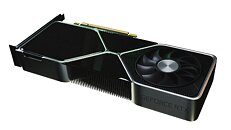- Joined
- Oct 9, 2007
- Messages
- 47,617 (7.44/day)
- Location
- Dublin, Ireland
| System Name | RBMK-1000 |
|---|---|
| Processor | AMD Ryzen 7 5700G |
| Motherboard | Gigabyte B550 AORUS Elite V2 |
| Cooling | DeepCool Gammax L240 V2 |
| Memory | 2x 16GB DDR4-3200 |
| Video Card(s) | Galax RTX 4070 Ti EX |
| Storage | Samsung 990 1TB |
| Display(s) | BenQ 1440p 60 Hz 27-inch |
| Case | Corsair Carbide 100R |
| Audio Device(s) | ASUS SupremeFX S1220A |
| Power Supply | Cooler Master MWE Gold 650W |
| Mouse | ASUS ROG Strix Impact |
| Keyboard | Gamdias Hermes E2 |
| Software | Windows 11 Pro |
NVIDIA's GeForce RTX 20-series "Turing" graphics card series did not increase video memory sizes in comparison to GeForce GTX 10-series "Pascal," although the memory itself is faster on account of GDDR6. This could change with the GeForce RTX 30-series "Ampere," as the company looks to increase memory sizes across the board in a bid to shore up ray-tracing performance. WCCFTech has learned that in addition to a variety of strange new memory bus widths, such as 320-bit, NVIDIA could introduce certain higher variants of its RTX 30-series cards with video memory sizes as high as 20 GB and 24 GB.
Memory sizes of 20 GB or 24 GB aren't new for NVIDIA's professional-segment Quadro products, but it's certainly new for GeForce, with only the company's TITAN-series products breaking the 20 GB-mark at prices due north of $2,000. Much of NVIDIA's high-end appears to be resting on segmentation of the PG132 common board design, coupled with the GA102 silicon, from which the company could carve out several SKUs spaced far apart in the company's product stack. NVIDIA's next-generation GeForce "Ampere" family is expected to debut in September 2020, with product launches in the higher-end running through late-Q3 and Q4 of 2020.

View at TechPowerUp Main Site
Memory sizes of 20 GB or 24 GB aren't new for NVIDIA's professional-segment Quadro products, but it's certainly new for GeForce, with only the company's TITAN-series products breaking the 20 GB-mark at prices due north of $2,000. Much of NVIDIA's high-end appears to be resting on segmentation of the PG132 common board design, coupled with the GA102 silicon, from which the company could carve out several SKUs spaced far apart in the company's product stack. NVIDIA's next-generation GeForce "Ampere" family is expected to debut in September 2020, with product launches in the higher-end running through late-Q3 and Q4 of 2020.

View at TechPowerUp Main Site









